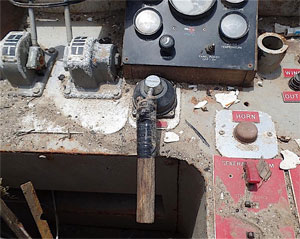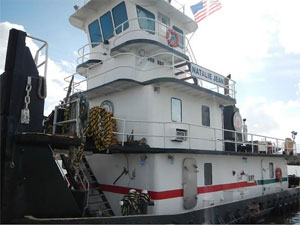The towboat Natalie Jean and its empty barge struggled against a steady wind and the swollen Mississippi River when the pilot steered toward the main channel from the west bank. Doing so meant snaking between two ships anchored in the New Orleans General Anchorage.
The 200-foot barge IB 1957 cleared the bulk carrier Atlantic Fairy and the pilot turned to starboard, but the 64-foot Natalie Jean snagged the ship’s port anchor chain, the National Transportation Safety Board (NTSB) said in its accident report.
“The tow then became pressed about perpendicularly against the bulbous bow of the Atlantic Fairy and also against the bulker’s starboard anchor chain,” the report said. “The Natalie Jean subsequently heeled to port, and the port tow wire parted under tension. Seconds later, Natalie Jean capsized and the barge broke free. Natalie Jean then quickly sank.”
Crewmembers Malon Dawsey of Pearlington, Miss., and Karl Prince of Houma, La., died in the incident, which occurred at 0938 on March 12, 2018. The pilot, identified in local media as Paul Trahan, escaped into the river and was rescued by the towboat Earl Gonsoulin.
The NTSB identified numerous issues with the voyage, which occurred when the river was at 17 feet, considered minor flood stage. In particular, Natalie Jean’s operator, Creole Chief Inc., failed to follow its own towing safety management system (TSMS) upon hiring Trahan.
“The NTSB determines that the probable cause of the capsizing and sinking of the Natalie Jean was the company’s decision to place an inadequately vetted pilot on board the vessel who did not have previous experience operating the Natalie Jean,” the report said.
In a brief phone conversation, Stan Kraly, owner of Harvey, La.-based Creole Chief, declined to comment on NTSB findings. The New Orleans Advocate newspaper reported that the company has settled lawsuits stemming from the fatal sinking.
Kraly told investigators his company got a job delivering a fuel barge from Zito Fleet at mile marker 105 to Stolthaven at mile marker 79. None of Creole Chief’s pilots were available, so Kraly called Trahan, whom he had met about a week earlier. Trahan agreed to the assignment.
At the time, Trahan had more than 35 years of experience running towboats and working in the oil industry. He retired about a year earlier and hadn’t helmed a commercial vessel in eight months. He was working to renew his Coast Guard credential issued in 2013 to pursue part-time work, the NTSB said.
Kraly and Trahan met at a fuel distribution dock at 1600 the day before the incident for a quick orientation. The two focused on the job at hand, river conditions, station bills and other details. Key safety information, including abandon-ship and man-overboard protocols, were not discussed, Kraly told investigators.
 |
|
A photo taken after Natalie Jean was salvaged shows the primary steering control, which had been modified with a wooden rod taped to the end to extend it. |
|
U.S. Coast Guard/NTSB |
Natalie Jean, with no barge in tow, got underway soon afterward with Trahan steering and the captain supervising. Trahan remained at the helm after picking up the loaded fuel barge and turning downriver for the delivery voyage. That leg also was uneventful, although Trahan had some difficulty getting used to the controls.
After arriving at Stolthaven, the captain offered to let the pilot sleep while the fuel was discharged. The pilot returned to the wheelhouse at about 0300 after seven hours of sleep. While he was sleeping, the National Oceanic and Atmospheric Administration (NOAA) issued a flood warning for the Lower Mississippi River around New Orleans. Neither the river conditions nor the weather were discussed during the watch turnover briefing, despite company policy to include this information.
Winds reached 26 knots as Natalie Jean got underway at 0500 to return upriver with the empty barge. Trahan, back at the helm, opted to stay close to the west bank due to the strong winds. The towboat and barge zigzagged at less than 2 knots for much of the voyage, data showed.
Atlantic Fairy was anchored roughly 550 feet downriver from the cargo ship Vancouverborg at the General Anchorage. Natalie Jean had barely begun its turn toward the center of the river when it snagged the anchor chain. The fast current pushed the towboat and barge against the ship.
“When I started my maneuvers to get between the ships, the barge (had) already cleared the ship that I was alongside, the Atlantic Fairy,” Trahan told investigators. “Half of my boat was cleared, basically, abreast of the anchor chain, and next thing I knew I’m close to the (port) anchor chain. … By that time, my boat and the barge (were) turning sideways.”
Dawsey and Prince were found inside Natalie Jean when it was salvaged about three months later. Total damage exceeded $500,000, the report said.
The NTSB said Dawsey and Prince both held master’s credentials. It is not clear which crewman served as master on the voyage.
Creole Chief had a TSMS in place for nearly 20 months before Natalie Jean sank. It required drug testing for new hires among other standard pre-employment verification. Trahan never underwent drug testing before he came on board Natalie Jean, and the NTSB said he was never tested after the incident.
Investigators determined the company failed to follow its own requirements for new hires. In addition to omitting the drug test, Creole Chief did not confirm the pilot’s training or credential or verify his ability to safely handle the vessel.
“The pilot’s lack of vessel knowledge and experience, coupled with high water, strong beam winds and a vessel able to make only 1-2 mph in a strong 5-mph current while pushing a barge upriver through a busy anchorage, placed him in a very challenging situation,” the report said.

